 |
| The Independent Traveler's Newsletter PAGE FOUR |
 |
| The Independent Traveler's Newsletter PAGE FOUR |
|
FEATURING LIMOUSIN: le Creuse et la Corrèze - Part 2 of 2
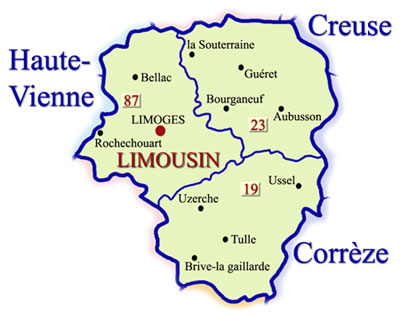 The Creuse [23] The Creuse [23] . . . at the northeast of Limousin, is a very rural area known as an ecotourisim destination since the 1990s. Never overrun by tourists and without a major urban center, it is populated with abbeys, castles and other heritage sites and dotted with Celtic monuments. The weather is temperate with sunny winters, despite being quite cold, and the summers are never too hot. The forests are protected, the air is clean, and the architecture appeals to many who wish to live in the Creuse from other regions of Europe. Aubusson Perhaps best known to the outside world is the city of Aubusson which is famous for its tapestries, Aubusson rugs and the tapestry museum that is a major attraction for visitors. Aubusson dates from Gallo-Roman times, and its Camp des Châtres, once believed to be a Roman fortress, is now deemed far older and attributed to the Iron Age. But, without a doubt, tapestries and carpets are the lifeblood of Aubusson. They have been famous throughout the world since the 16th century when, in 1580, Flemish weavers took refuge here. It was in the 17th century that the tapestries were given 'Royal Appointment' status, and only after the French Revolution did they see a downturn in their fortunes. Wallpaper became the new method of covering walls at that time, and it was only in the first part of the twentieth century when artists such as Dufy, Braque, Cocteau and others came to Aubusson and created works in wool. That renewed interest in the city and the artistic talents of the weavers who produced the carpets and tapestries. Aubusson tapestries are still in demand today and still being produced using traditional methods. They can be found throughout the world, with one of the most famous having been installed in Coventry Cathedral in 1962. The monastery, Abbaye de Moutier d'Ahun, some 18 kilometers southwest of Guéret, has 17th century wood carvings, and the River Creuse flows through the center of the village. Notable are several towns with pacifist memorials erected after World War I. These commemorated the families of soldiers who died in the War, and the best known is Gentioux-Pigerolles. The members of the military were then and are today quite displeased that the soldiers themselves weren't honored by these memorials. 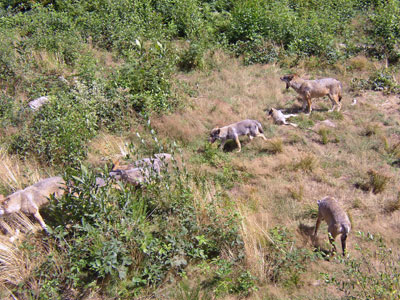 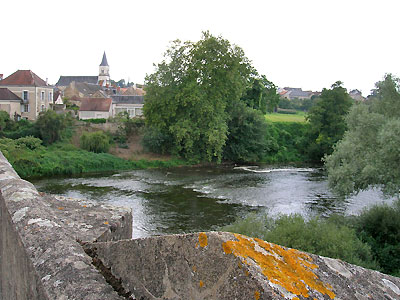 Guéret is the prefecture of the Creuse and its principal city. Nearby is the Monts de Guéret Animal Park and Les Loups de Chabrières, home to the few wolves remaining in France. The park was built in 2001 in the forest. Historically, European grey wolves populated the Creuse forests, but the last one died in 1937. They are back, with two dozen living in semi-freedom there in two large forested enclosures. In recent years Mackenzie wolves, both white and black, were introduced from Canada and white arctic wolves have been added to the dominant (by number) grey wolves. They joined the other species living in the park's forests ~ deer, roe deer, wild boar (sanglier), badgers and foxes. . . . in the south boasts the highest number of Plus Beaux Villages in Limousin ~ five to be exact. They are Collonges la Rouge where the Association had its beginnings and which was the first village, Saint Robert, Curemont, Ségur-le-Château and Turenne. Each of them is worth a visit! The Most Beautiful Villages of France was the brainchild of a former Collonges la Rouge mayor, Charles Ceyrac, in 1982 after seeing an article about France's beautiful villages in the Readers Digest! He was already concerned with tiny rural hamlets and towns off the beaten track that were neglected and falling into ruin. He began with 66 of these villages in the association with the goal of restoring and preserving them. The criteria to join today is rather strict, but if you've ever visited one of the 154 villages, you will understand why. They are not intended to be living museums but good examples of French country living looking toward the future but preserving the best of the past. Turenne One of the Corrèze's 'most beautiful villages' and one of the most interesting is Turenne with a population under 800. The lords of Turenne resisted Viking invaders, proving how powerful they were, which led to independence from Royal rule. By the 15th century, Turenne controlled over 1200 villages and several abbeys, and the viscounts of Turenne had absolute rule, even to the point of collecting taxes. The town's inhabitants lived peaceful lives, protected by their powerful lord and paying lower taxes than other French peasants of their day. But in 1738 all of that changed ~ the last viscount, penniless, sold the viscounty to Louis XV. Taxes were then raised tenfold! When you visit Turenne today you will enjoy the pretty village especially the church built in the 16th and 17th centuries in the form of a Greek cross, the elegant homes in the Barri-bas quarter (the old town at the bottom of the hill), and the remains of the château (only the clock and Caesar's clock tower) destroyed by the King once the viscounty was purchased by the crown. Collonges la Rouge We've had the pleasure of visiting Collonges la Rouge and Saint Robert in recent years (our photos below), and we knew that we were somewhere special. Saint Robert, as all the Plus Beaux Villages in France, is small, immaculate, pretty and has a population of under 2000. Each village in the Association must have at least two national heritage sites as well. Note that the photo on our first page is the view from Saint Robert's churchyard. 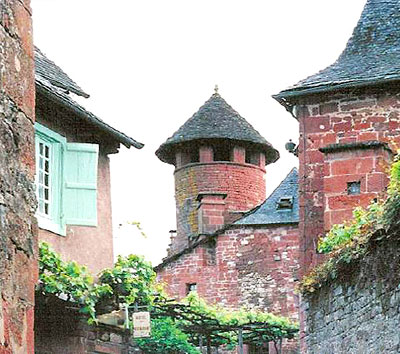  Collonges la Rouge and Saint
Robert, in the Corrèze département of Limousin
It endured the French wars of religion, but the French Revolution caused the destruction of the priory buildings. It wasn't until the beginning of the 19th century that the village regained some semblance of prosperity, which was short-lived. Income from vineyards ceased when phylloxera destroyed the vines at the end of the 19th century as it had in many areas of France. The population began to leave, and the village remaining was primarily limited to the red sandstone quarry! This sad part of their history is hard to believe if you visit Collonges la Rouge today. The association, Les Amis de Collonges, was formed at the beginning of the 20th century to restore the village, and today tourism is an important income generator for Collonges. Brive La Gaillarde Only ten kilometers from the border with the Périgord, Brive La Gaillarde has a rail station and a nearby airport for those coming to the Corrèze. With a population of about 50,000, it is a good place for shopping, dining and market days on Tuesday, Thursday and Saturday mornings. Known for its friendly people and relaxed atmosphere, the word Gaillarde means 'charming' when in Medieval times it meant 'fortress' or 'brave'. Visit the Medieval quarter, primarily home to retail shops, cafés, government buildings and a museum. There are many gardens and parks for visitors to enjoy, and although it is the largest metropolis in the Corrèze, the département capital is Tulle [see below].  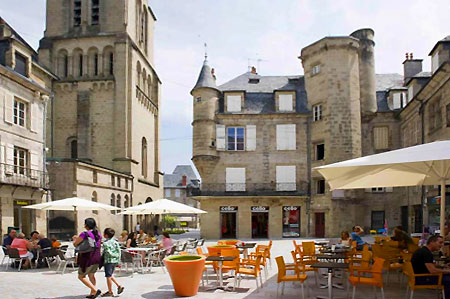 Spend some relaxing time in Brive's Old Town Not far from Brive, cave fanciers can explore Gouffre de la Fage (chasm) whose underground galleries are home to six species of bats. South, along the D920, in the direction of Cahors, are the Grottes de St-Antoine, sandstone caves used by St Anthony of Padua when he lived in Brive. Franciscans still provide a hospitable welcome there for visitors. Then there are the Grottes de Lamouroux, a group of caves in tiers and used in the past in times of danger. Tulle The city of Tulle is the prefecture for the Corrèze. Tulle, almost two thirds smaller than Brive in population, is an historic city with houses on terraces overlooking the River Corrèze. It boasts an elegant cathedral reconstructed from a church by the Abbott Guillaume beginning in 1103, and there is also Tulle Abbey, founded on the site of a Roman temple dedicated to the goddess Tutela. When visiting the city, don't miss the 13th century Cloisters whose two restored galleries are all that remain standing after much damage over the years. Uzerche Finally, we will visit Uzerche, with a population of under 4000 residents, and a town filled with well-constructed mansions and older homes. Set on a hill overlooking the River Vézère adds to its appeal. Many building have bell towers and pepper-pot roofs, but what is even more interesting than its architecture is its amazing history, for it was here that the Saracens were duped! 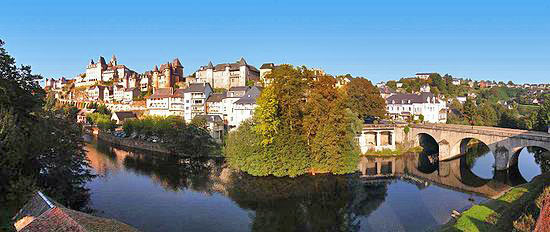 Uzerche on the River Vézère It was the year 732 when the famed Frankish hero, Charles Martel, grandfather of Charlemagne, defeated the Saracens at Poitiers. The fleeing forces then attached Uzerche, but the town had the protection of high walls and eighteen fortified towers so it was able to hold back the invaders for seven years!! Starving and near surrender, the townspeople decided to trick their enemy by an offering of food ~ an offering to convince the Saracens that Uzerche had ample stores and could continue to hold out. They presented the emir with their last calf and all their corn. The Moors gave up the siege. Uzerche never lost in any siege of the Middle Ages and, to this day, its crest bears words that translate 'never sullied'. The Corrèze's green valleys and plateaus are perfect for sheep grazing, and plantations of truffle oaks as well as orchards are plentiful. Waterfalls will surprise you, and picturesque villages can be found as you drive the winding roads of the département. The locals like to think that water and stones survive together well in the Corrèze as evidenced by bridges still standing that were built by the Romans. Lovers of the out-of-doors and nature will appreciate the Corrèze's eastern boundary with the Auvergne where they'll discover the Gorges de Dordogne and the Gorges du Chavanon. On the wild River Vézère south of Vigeois in the northwest is the Gorges du Saillant, and the Gorges de la Cère is at the département's most southern point. Dozens of small rivers traverse the area, and it is a green and hilly region of France with several large lakes. The many scenic routes invite exploration by car. 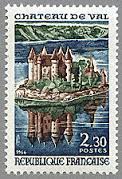
At the
most southeastern
tip of
Corrèze near the border with the département of Cantal in
the Auvergne,
is the village of Bort-les-Orgues and the Château de Val.
The château
is actually farther north in the Auvergnais
hamlet of Lanobre, but through some mystery of French ownership, it
belongs to Bort-les-Orgues in the Corrèze. It sits 30
meters high
above a lake created by the construction of the Bort Dam, and the
château welcomes visitors to exhibitions and concerts in this
truly
breathtaking setting. The Republic of France issued a stamp
honoring Château de
Val, shown here. It is surrounded on three sides by the lake, and
is a popular destination for visitors to the Corrèze. Whether you have an interest in the
porcelain factories of Limoges, the tapestry weavers of Aubusson, or
the natural wonders and historic villages of the Creuse and the
Corrèze, there is something for you in Limousin. There
were the famous stonemasons
of the Creuse who are credited with the construction of so many
important buildings throughout France. When times were difficult
at home, the stonemason went to Paris. Evidence of the expertise
they gained there can be found throughout the Creuse. The typical
granite houses are solidly built and wood was only used for windows or
a lintel here and there. Even outbuildings were made with the
same care, some with sculpted doorways and carvings over the entrances.
Do try to include Limousin on your next French vacation itinerary. You will find a lifestyle and tranquility that is very enviable, and you will experience French country life at its best.
Where
to stay: In
the Haute-Vienne, featured in our
last issue, we highly recommend
DISCLAIMER: You have received this newsletter because your email address is on our Opt-In mailing list, i.e., you have requested to receive FRANCE On Your Own ©. If you would like to discontinue receipt of this newsletter, please send an email to publisher@franceonyourown.com with "unsubscribe" on the Subject line. Unless indicated otherwise, photos, graphics, artwork and text in the FRANCE On Your Own © newsletter are all the property of Cold Spring Press and FRANCE On Your Own © and cannot be copied, duplicated or used in any manner by anyone without the express written permission of Cold Spring Press. FRANCE On Your Own © is published online by Cold Spring Press, P O Box 26098, San Diego, California 92196-0098. This publication is copyrighted and no portions of the text, artwork, graphics or photographs may be reproduced or distributed in any form or by any means or stored in a database or retrieval system without the written permission of the Publisher. For more information about FRANCE On Your Own ©, visit our web site at http://www.franceonyourown.com. Recommendations made in this newsletter are based upon the personal experiences of the Publishers or contributing writers solely to provide information to subscribers. Cold Spring Press and FRANCE On Your Own © make no endorsements nor are any guarantees or promises of satisfaction given or implied. Any and all information is correct to the best of our knowledge, and the Publishers accept no responsibility for errors and/or omissions. The responsibility lies entirely with the traveler to obtain current information regarding accommodations, availability, schedules, prices, reservations, or any other pertinent details. We do not guarantee the historical accuracy of the contents of articles in this newsletter. Historical accuracy is dependent upon one's sources of information -- and contradictions often exist among those sources. Links to other web sites or email addresses are provided for informational purposes only and do not imply any guarantees of service or endorsement of any organization or their business practices. FRANCE On Your Own © is electronically transmitted via email. To add your email address to our database for this FREE newsletter, send an email to info@franceonyourown.com, and please put Subscribe in the subject line. We do not share email addresses with any other organization. BACK ISSUES of the print version of FRANCE On Your Own © and Free online back issues are available on our web site at http://www.franceonyourown.com/Archives.htm. ©1997-2016
Cold Spring Press All Rights Reserved
|
|
 previous
page
previous
page |